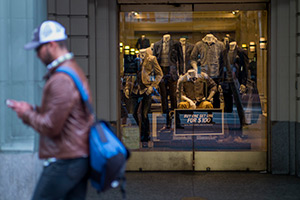Consumer Sentiment Cools, Capping Best Quarter Since 2004

Consumer confidence fell less than forecast in March, capping the best quarter since 2004 as the labor market stayed strong and gasoline prices leveled off.
The University of Michigan said March 27 that its final index of sentiment cooled to 93 this month from 95.4 in February. The median projection in a Bloomberg News survey of economists called for 92 after a preliminary March reading of 91.2. The average from January through March was the highest since the third quarter of 2004.
Much of the drop in confidence was among lower-income households, the ones most affected by rising utility bills after colder weather the month before. At the same time, fuel costs have steadied since early March, employers are adding workers and younger and higher-income earners are more upbeat about the prospects for wages.
“Overall this is a good reading,” Richard Curtin, director of the Michigan Survey of Consumers, said on a conference call after the release. “It certainly will support expanding consumer expenditures.” What’s more, wage-growth expectations are “starting to spread and broaden.”
Estimates in the Bloomberg survey of 64 economists ranged from 91 to 94. Even with the decline in March from a month earlier, the gauge is higher than the 88.8 average for the five years leading to the last recession that started in December 2007. In January, the Michigan index climbed to 98.1, the highest since the start of 2004.
The Michigan sentiment survey’s current conditions index, which takes stock of Americans’ view of their personal finances, cooled to 105 from the prior month’s 106.9 in February.
The measure of expectations six months from now decreased to 85.3 from 88.
Budgets for some Americans, especially those living in the eastern U.S., took a hit this month from higher heating bills. Some 23 states had a top-10 coldest February and nine had their second-coldest, according to the National Oceanic and Atmospheric Administration. Residents in Chicago and Cleveland observed record-low February temperatures.
“The January surge in confidence was partly due to falling gasoline prices and the small retreat since then was partly due to the unusually harsh winter,” Curtin said in a statement. “Importantly, most of the recent variation was among lower-income households, whose budgets are more sensitive to higher utility costs and disruptions in work hours.”
Colder weather and snow in some regions may also help explain some of the slowdown in consumer spending this year after fourth-quarter figures showed the biggest gain in eight years. Retail sales dropped in February for a third month, according to the Commerce Department.
Household consumption, including outlays for services, climbed at a 4.4% annualized rate from October through December, helping the economy expand 2.2%, Commerce Department data on March 27 showed.
Americans expect the inflation rate in the next year will be 3 %, compared with 2.8% in February, according to the University of Michigan’s report. Over the next five to 10 years, they expect a 2.8% rate of inflation, compared with 2.7% in the previous month.
The average cost of regular gasoline was $2.43 on March 26, little changed from the end of February, according to data from AAA, the biggest U.S. motoring group. Nonetheless, prices are up from a six-year low of $2.03 reached on Jan. 25.
While a steady climb in sentiment from July of last year to January can be owed to falling fuel costs during that time, a pickup in employment opportunities is playing a role as well. Employers added 295,000 workers in February, the 12th straight month payrolls have increased by at least 200,000, Labor Department data showed on March 6. The unemployment rate fell to 5.5%, the lowest in almost seven years.
Wage gains have been slow to follow suit. Average hourly earnings were up 2% over February 2014, matching the increase on average since the expansion began in mid-2009.
“While consumer optimism has thus far been built on job gains, spending gains will be paced by younger and higher-income households who now anticipate higher wage gains during the year ahead,” Curtin said.
In an effort to reduce turnover and cope with an increasingly competitive labor market, Wal-Mart Stores Inc., the largest U.S. discount chain, revealed plans in February to boost hourly pay. Target Corp. may follow.
Restaurant chain Denny’s Corp. is among companies attributing some of their sales momentum to household sentiment and increased hiring.
“Consumer confidence, employment are the two strong drivers to dine-out traffic,” Chief Executive Officer John Miller said during a conference presentation on March 24. “If you’re employed you have disposable income, you tend to eat out.”




